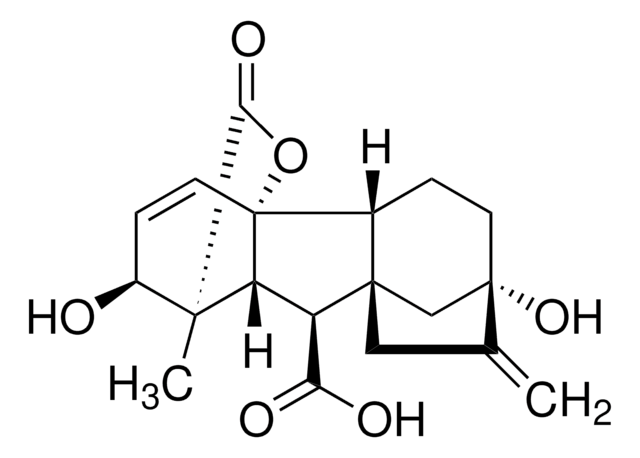D70724
2,4-Dichlorophenoxyacetic acid
97%
Synonym(s):
2,4-D
Sign Into View Organizational & Contract Pricing
All Photos(3)
About This Item
Linear Formula:
Cl2C6H3OCH2CO2H
CAS Number:
Molecular Weight:
221.04
Beilstein:
1214242
EC Number:
MDL number:
UNSPSC Code:
12352100
PubChem Substance ID:
NACRES:
NA.22
Recommended Products
vapor pressure
0.4 mmHg ( 160 °C)
Quality Level
Assay
97%
form
solid
mp
136-140 °C (lit.)
SMILES string
OC(=O)COc1ccc(Cl)cc1Cl
InChI
1S/C8H6Cl2O3/c9-5-1-2-7(6(10)3-5)13-4-8(11)12/h1-3H,4H2,(H,11,12)
InChI key
OVSKIKFHRZPJSS-UHFFFAOYSA-N
Looking for similar products? Visit Product Comparison Guide
General description
2,4-Dichlorophenoxyacetic acid is a widely used herbicide that decomposes in the presence of water and ultraviolet light to form polymeric humic acids.
Signal Word
Danger
Hazard Statements
Precautionary Statements
Hazard Classifications
Acute Tox. 4 Oral - Aquatic Acute 1 - Aquatic Chronic 3 - Eye Dam. 1 - Skin Sens. 1 - STOT SE 3
Target Organs
Respiratory system
Storage Class Code
11 - Combustible Solids
WGK
WGK 2
Flash Point(F)
Not applicable
Flash Point(C)
Not applicable
Personal Protective Equipment
dust mask type N95 (US), Eyeshields, Gloves
Choose from one of the most recent versions:
Already Own This Product?
Find documentation for the products that you have recently purchased in the Document Library.
Customers Also Viewed
Manoharan Rajesh et al.
Protoplasma, 251(5), 1231-1243 (2014-03-19)
Podophyllum hexandrum Royle known as Indian mayapple is an important medicinal plant found only in higher altitudes (2,700 to 4,200 m) of the Himalayas. The highly valued anticancer drug Podophyllotoxin is obtained from the roots of this plant. Due to
Heping Han et al.
Pest management science, 69(9), 996-1000 (2013-06-21)
The auxinic herbicide 2,4-D amine is known, in vitro, as a cytochrome P450 inducer. The current study uses 2,4-D pre-treatment, at the whole plant level, to study mechanism(s) of non-target site based herbicide resistance to the ACCase-inhibiting herbicide diclofop-methyl in
The microbial degradation of 2,4-dichlorophenoxyacetic acid in soil.
E R Sandmann et al.
Reviews of environmental contamination and toxicology, 101, 1-53 (1988-01-01)
Carol J Burns et al.
Critical reviews in toxicology, 42(9), 768-786 (2012-08-11)
A qualitative review of the epidemiological literature on the herbicide 2,4-dichlorophenoxyacetic acid (2,4-D) and health after 2001 is presented. In order to compare the exposure of the general population, bystanders and occupational groups, their urinary levels were also reviewed. In
Environmental genomics: mechanistic insights into toxicity of and resistance to the herbicide 2,4-D.
Miguel Cacho Teixeira et al.
Trends in biotechnology, 25(8), 363-370 (2007-06-20)
Genomic information and tools are beginning to be used to increase our understanding of how organisms of all types interact with their environment. The study of the expression of all genes, at the genome, transcriptome, proteome and metabolome level, in
Our team of scientists has experience in all areas of research including Life Science, Material Science, Chemical Synthesis, Chromatography, Analytical and many others.
Contact Technical Service









